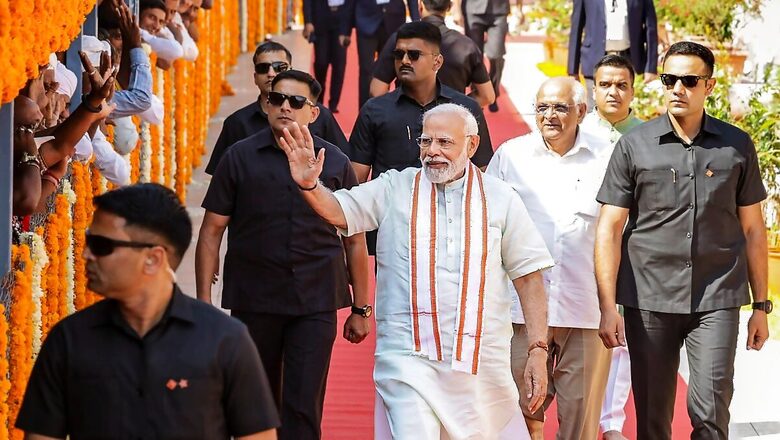
views
Day One of Prime Minister Narendra Modi’s two-day visit to his homestate Gujarat focused on “vikas and vishwas”, with a visit to a temple followed by dedication of development projects worth Rs 6,000 crore on Monday.
Talking about his home, Vadnagar, and his constituency, Varanasi or Kashi, Prime Minister Narendra Modi told the people of Gujarat that railways will utilise the potential of tourism in places such as Vadnagar. “The Gujarat model of development has been acknowledged by the world…Just like Kashi, Vadnagar has a lot of stories to tell and legacy to leave behind. Therefore, we must make the most of it and encourage the tourism potential. Railways is going to be a landmark step in that direction. The broad gauge network is a big step towards connecting this region to the rest of the country,” Modi said in his speech.
After landing in Ahmedabad, the prime minister headed to the revered Ambaji Temple in Banaskantha district. Modi, who is an ardent Maa Durga bhakt, has been visiting the temple for years. Last September, he announced a slew of development projects for the development of Ambaji.
Later, the PM reached Mehsana district, where he dedicated development projects worth Rs 6,000 crore — a pre-Diwali gift for the people of north Gujarat and, in particular his home district Mehsana. Mehsana is the district under which Vadnagar, where Modi spent a large part of his early life, falls.
Speaking about the development projects of Railways dedicated to the people of north Gujarat, Modi spoke about the push for development under the Bharatiya Janata Party (BJP) rule over the years, especially in the state. PM Modi stressed that the dedicated freight corridor will be revolutionary. “Not only will we benefit from the mode of transportation becoming cheaper, but it will be faster as well. Now, loaded trucks can be piled on top of trains and this will be a boon for our agrarian sector and farmers,” Modi said.
આજ રોજ અંબાજી ખાતે મા અંબાના દર્શન કર્યા અને સહુનાં સુખ, સમૃદ્ધિ અને ઉત્તમ સ્વાસ્થ્ય માટે પ્રાર્થના કરી. pic.twitter.com/cz8s7vLyOe— Narendra Modi (@narendramodi) October 30, 2023
THE VARIOUS DEVELOPMENT PROJECTS
The New Bhandu-New Sanand(N) section of the Western Dedicated Freight Corridor (WDFC); doubling of Viramgam-Samakhiali rail line; Katosan Road- Bechraji-Maruti Suzuki India Limited (MSIL Siding) rail project; project for recharge of various village lakes of Vijapur taluka and Mansa taluka of Mehsana and Gandhinagar district; Valasana barrage on Sabarmati river in Mehsana district; two schemes for provisioning of drinking water in Palanpur, Banaskantha; and the Dharoi dam-based Palanpur lifeline project — Head work (HW) and water treatment plant of 80 MLD capacity were inaugurated by Modi in Kheralu.
The projects whose foundation stones were laid by the Prime Minister include various development projects for providing irrigation facilities in Santrampur taluka of Mahisagar district; widening and strengthening of Naroda-Dehgam-Harsol-Dhansura Road, Sabarkantha; project for Kalol Nagarpalika Sewerage and Septage Management in Gandhinagar District; and projects for sewage treatment plants in Siddhpur (Patan), Palanpur (Banaskantha), Bayad (Aravalli) and Vadnagar (Mehsana).
Speaking at launch of multiple projects in Kheralu, aimed at enhancing the region’s infrastructure, economy and ease of living for the citizens. https://t.co/HFX98s1ORm— Narendra Modi (@narendramodi) October 30, 2023
What is DFCCIL?
The Dedicated Freight Corridor Corporation of India Limited (DFCCIL) is a Special Purpose Vehicle (SPV) established under the administrative control of the Ministry of Railways, Government of India. DFC is mandated for development, construction, operation and maintenance of the Eastern and Western Dedicated Freight Corridors, aimed at enhancing freight transportation capabilities in India using innovations and state-of-the-art technology.
વિવિધ વિકાસકાર્યોથી ઉત્તર ગુજરાત બનશે ઉત્તમથી સર્વોત્તમ…માનનીય પ્રધાનમંત્રી શ્રી @narendramodi જીએ મહેસાણાના ડભોડા ખાતે લાખોની જનમેદની વચ્ચે ગુજરાતને ₹5,950 કરોડના વિવિધ પ્રકલ્પોની ભેટ આપી.
આ પ્રસંગે માનનીય મુખ્યમંત્રી શ્રી @Bhupendrapbjp , પ્રદેશ અધ્યક્ષ શ્રી @CRPaatil ,… pic.twitter.com/uwE0p16uNV
— BJP Gujarat (@BJP4Gujarat) October 30, 2023
Its focus areas include:
- Automated New Track Construction (NTC) machine which can lay track at the speed of 1.5 km per day
- Train Protection and Warning System (TPWS) for safe and efficient operation
- State-of-the-art Operation Control Centres (OCCs) for the Western and Eastern sections
- Dedicated Freight Corridors at Ahmedabad and Prayagraj, respectively
- Elimination of road level crossing over DFC & parallel IR sections for faster and safer mobility to road and rail users through ROBs, RFOs and RUBs
- Automatic signalling with two-km spacing
- Longer sections i.e stations are situated at a distance of 40 km (approx.) for long-haul train operation.

















Comments
0 comment